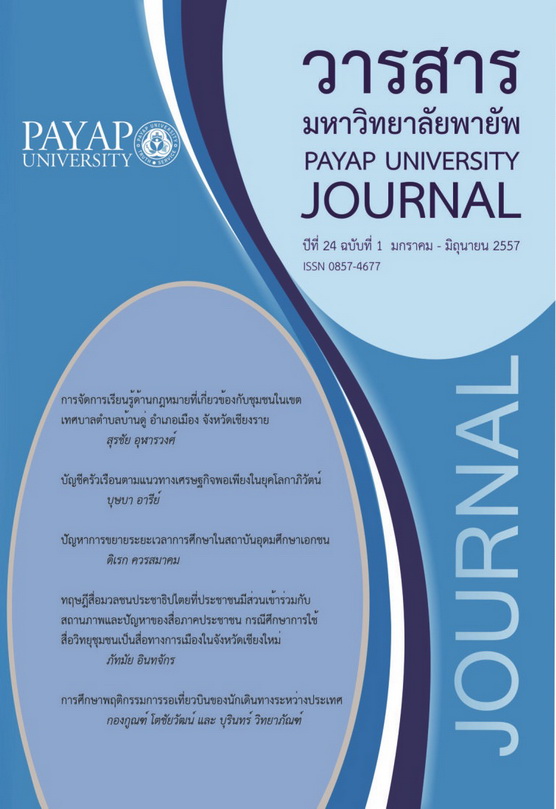ทฤษฎีสื่อมวลชนประชาธิปไตยที่ประชาชนมีส่วนเข้าร่วมกับสถานภาพและปัญหาของสื่อภาคประชาชน กรณีศึกษาการใช้สื่อวิทยุชุมชนเป็นสื่อทางการเมืองในจังหวัดเชียงใหม่
Main Article Content
บทคัดย่อ
บทความนี้มีจุดประสงค์เพื่อทำความเข้าใจและขยายความคิดต่อทฤษฎีสื่อมวลชนประชาธิปไตยที่ประชาชนมีส่วนเข้าร่วม ซึ่งเป็นหนึ่งในทฤษฎีกลุ่มบรรทัดฐานของสื่อมวลชน โดยหลักการสำคัญของทฤษฎีเน้นไปที่การรับรองว่า สื่อมวลชนต้องไม่มองประชาชนผู้รับสารเป็นเพียงผู้บริโภคหรือผู้ฟังผู้ชมที่เฉื่อยชาและเป็นผู้ไร้สิทธิ์ไร้เสียง แต่ต้องเคารพสิทธิที่จะแสดงความคิดเห็นของพลเมืองทุกคน องค์กรสื่อจะต้องแบ่งพื้นที่สำหรับการนำเสนอเนื้อหาจากภาคประชาชนหรือพลเมือง โดยยึดหลักสำคัญ 3 ประการคือ (1) เนื้อหาของสื่อต้องมีมุมมองจากประชาชน (2) ประชาชนต้องเข้ามามีส่วนร่วมในกระบวนการผลิตเนื้อหาของสื่อ (3) ประชาชนย่อมมีสิทธิเข้าถึงสื่อได้ ซึ่งหลักการดังกล่าวได้นำมาประยุกต์ใช้ในภาคปฏิบัติการของทฤษฎี ดังตัวอย่างของการจัดตั้งสื่อภาคประชาชน หรือสื่อของชุมชน ตัวอย่างเช่น การจัดตั้งวิทยุชุมชนในประเทศไทยและจังหวัดเชียงใหม่ อย่างไรก็ดี เมื่อสื่อของชุมชนได้เข้าไปมีส่วนร่วมกับวิกฤตการณ์ทางการเมืองของไทย นับตั้งแต่ปลายปี 2551 จนถึงปัจจุบัน สื่อชุมชนชนิดนี้ก็ได้กลายสภาพเป็นสื่อทางการเมืองอย่างเต็มตัว ซึ่งผู้เขียนมีข้อกังวลว่าจะสร้างความแตกแยกแก่ประชาชนในชาติได้อย่างคาดไม่ถึง
Article Details
เอกสารอ้างอิง
จดหมายข่าวคณะกรรมการรณรงค์เพื่อการปฏิรูปสื่อ ปีที่ 1 ฉบับที่ 1 เดือนเมษายน - พฤษภาคม 2550.
ไชยรัตน์ เจริญสินโอฬาร. (2553). ว่าด้วยความคิดทางการเมืองของฌาคส์ ร็องซีแยร์ การเมืองของสุนทรียศาสตร์ กวีนิพนธ์ของความรู้. กรุงเทพฯ: สมมติ.
พรเทพ เฮง. (2550). นโยบายสาธารณะเพื่อคุณภาพชีวิตที่ดี: เส้นทางปฏิรูปสื่อ. กรุงเทพฯ: มูลนิธิสาธารณสุขแห่งชาติ.
พีระ จิระโสภณ. (2548). “ทฤษฎีการสื่อสารมวลชน หน่วยที่ 10” ในประมวลสาระชุดวิชาปรัชญานิเทศศาสตร์และทฤษฎีการสื่อสาร หน่วยที่ 8-15. นนทบุรี: โรงพิมพ์ มหาวิทยาลัยสุโขทัยธรรมาธิราช.
พิชาย รัตนดิลก ณ ภูเก็ต. (24 - 30 กันยายน 2554). ความรุนแรงทางการเมืองไทยร่วมสมัย: การปฏิบัติเชิงวาทกรรมของลัทธิแดงนิยม (2). เอเอสทีวีผู้จัดการ สุดสัปดาห์, 49.
ภัทมัย อินทจักร. (มิถุนายน – กันยายน 2554). การสร้างความเป็นจริงเรื่องประชาธิปไตยผ่านสื่อวิทยุชุมชนของกลุ่มรักเชียงใหม่’51. วารสารร่มพฤกษ์, 29(3), 59-84.
วิทยุชุมชนสันป่าตอง. (2549). เอกสารเผยแพร่. เครือข่ายวิทยุชุมชนภาคเหนือ 17 จังหวัด.
สภาร่างรัฐธรรมนูญ. (2550). ร่างรัฐธรรมนูญแห่งราชอาณาจักรไทย ฉบับลงประชามติ วันอาทิตย์ที่ 19 สิงหาคม 2550. กรุงเทพฯ: ศูนย์สื่อและสิ่งพิมพ์แก้วเจ้าจอม มหาวิทยาราชภัฏสวนสุนันทา.
Berrigan, Frances J. (1981). Community Communication : the role of community media in development. Paris: UNESCO Press.
Bromley, R. (n.d.). Beast, Vermin, Insect: Hate Media and the construction of the enemy.
The case of Rwanda, 1990-1994. Retrieved April 4, 2010, from https://www.ru.ac.za/documents/Politics/Bromley%20final.doc
Bruce Girard eds. . A Passion for Radio : Radio Waves and Community. (electronic edition 2001: www.comunica.org/passion (retrived July20th, 2009)
Jankowski, Nicholas W. and Prehn ,Ole eds. (2002). “the Conception Contours of Community Media” in Community Media in the Information Age: perspectives and prospects. NJ: Hampton Press.
McKenzie, Robert. (2006). Comparing Media from around the world. Boston: Allyn & Bacon.
McNair, B. (2007). An Introduction to Political Communication (4th ed). London : Routledge.
McQuail, Denis (1994) . Mass Communication Theory (3rd ed). Thousand Oaks, CA: Sage Publications.


